I started diving in February 2000, and obtained by PADI Open Water certification in May 2000 at Porpoise Bay, B.C. That August, I obtained by Advanced Open Water certification at Lake Minnewanka, Alberta. Then, in October 2000 I obtained by Rescue certification at Two Jack Lake, Alberta. I started work on my Divemaster certification that November, and completed it in October, 2001.
During that time, I have made many fun dives, including a Wreck Trip to Porpoise Bay B.C. in February 2001. We dove the HMCS Chaudiere several times, and obtained a wreck diver certification.
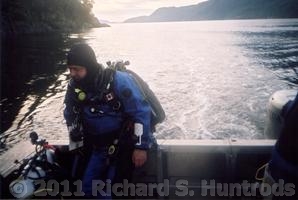
Since completing my Divemaster rating, I have become very interested in Technical Diving (TEK). I obtained my Nitrox and Advanced Nitrox certifications from TDI.
In February 2003, I started diving with a local group of technical divers who dive the DIR (Doing It Right) philosophy. Since then, I have converted my gear to the DIR rigging, and also dive the DIR philosophy. DIR is more than just a "gear configuration" way of diving. It is a "whole life" dive philosophy that emphasises team work and whole body fitness and health.
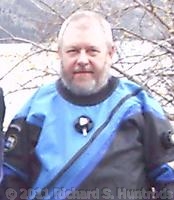
In December 2003, I bought a Gavin scooter, which makes the cold mountain lake dives a lot more fun! A knee injury on my first winter dive (slipped on the ice at the edge of Minnewanka) curtailed my diving somewhat.
Most recently (August 2004), I took a course from GUE (Global Underwater Explorers) called DIR Fundamentals. This was a most fantastic dive course, involving much team diving and skill building. I have much to learn and practice.
I followed that up with a Scooter course (August 2004) from the same instructors. This course taught us everything from maintenance and repair to basic skills and evasive manoevers. This was both fun and challenging.
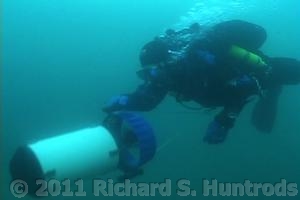
This past year I have continued to train in Forget-Me-Not (spring) and Minnewanka (summer and fall), with additional fun dives to Jasper (Patricia Lake to see the Habbakuk Project) and Twin Lakes. I also traded the Gavin for the smaller, lighter X-Scooter.
We dive almost year-round in Alberta. The mountain lakes are always cold (33F in winter to 52F in August), so drysuits and good underwear are always required. The only times we cannot dive are just after the lakes freeze (until the ice thickness builds up) and just after spring runoff (0ft. visibility) in April. The rest of the time we dive - even February and March are anticipated for the excellent Ice Diving in Minnewanka.
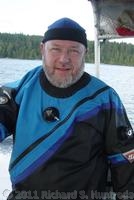
Just after Christmas, 2005 I participated in a terriffic deep dive drip to Nanaimo BC with Greg Mossfeldt, TL Kokot, Jeff Grimson, Doug Barselleaux and Mike Burgess (images and trip report on the 'Nanaimo' link below). During that trip, Linda and I decided that we would consider moving to Vancouver Island - something that we had wanted to do since our annual holidays in the 80's and 90's. As things turned out, we were able to move to the island in July 2006, near Ladysmith BC, just north of the 49th parallel.
Now I am able to dive year-round in a pretty temperate climate, with water temps in the 40-50 degree (F) range all the time. There are numerous shore dives, with abundant wildlife to see at every turn. This is truely a diver's heaven.
 adjusted.jpg)
Rebreather diving is not at all like 'open circuit" SCUBA diving. My diving on the west coast was done technical style, with twin 104cf tanks, harness and backplate, and other standard technical gear. The tanks, manifolds and regulators weighed in excess of 100 lbs on land. Underwater, they were just heavy enough to offset my buoyancy, so they were no problem to dive with. Trim was handled by tank band position and/or a keel weight, and small trim adjustments could be made while diving by varying lung volume.
With CCR (closed circuit rebreather) diving, all of the diver's gas is recirculated through a scrubber which removes CO2, plus a system that reads oxygen content in the gas and injects pure O2 to keep the oxygen partial pressure at a constant pre-set level. There are no bubbles from this unit during most of the dive - meaning it is almost totally silent underwater. However, because your breath is recycled, lung volume cannot be used for small trim adjustments - everything is done using the wing or suit. It takes some getting used to. A by-product of this gas recirculation is that you always breath warm, moist air instead of the colder, dry air from a SCUBA tank. This helps to keep you warm on the long dives - and CCR dives can be upwards of 5 hours long if you want!
The Prism is a CCR that has undergone extensive engineering, design and testing. There are many elements of this unit that appeal to me as an engineer. The scrubber is a radial configuration, meaning the gas enters down the center of the scrubber and exits out the sides in a radial pattern. This provides very easy 'work of breathing' under all conditions, even with the scrubber very firmly packed. The unit can be computer driven, with automatic PO2 set-point operation, but you can also fly the unit manually if you want by turning off the computer and reading the PO2 directly from the oxygen sensors on a secondary display, and manually injecting O2 as required to maintain a setpoint. The unit is well made from aerospace composities. The use of composite materials gives the unit a "garage build" look, but don't be fooled - the materials and processes are right from NASA and are mil-spec.
One change that I made as soon as I came home was to remove the recreational style BCD from my Prism, and replace it with a technical backplate and harness. This required several pieces of custom gear, purchased from Deep Sea Supply - a backplate-to-prism adapter place (6 bolts to 2) and a 2 bolt counter-lung yoke. The plate was 6lbs, taking some weigh off my weight belt. Together with my normal tech diving stainless steel Halcyon backplate any my 38lb AGIR wing, this gave me a very nice streamlined rig in the technical harness that I am most comfortable diving. Still, I required a heavy weight belt. To remove more weight from the belt, I poured a lead keel weight that sits in the channel of the backplate between the two bolts. This removed a further 6 lbs from my weight belt. With this rig, I only needed 16 lbs on a belt to dive. In July, Mike Burgess brought me a custom fabricated stainless steel Prism backplate that he had created for his own unit by a machine facility in Calgary. This plate is a direct replacement for the composite plate provided with a stock Prism. The advantage of this plate, besides strength, is that it removes a further 10lbs from the weight belt. Now, with only 6lbs requried besides the Prism, all I needed was to hand a couple of 3lb weights off my rig. This proved very sweet to dive. The final configuration change that I made was to move my Argon bottle (suit inflation) from the harness webbing to the backplate. Both Mike and I are also experimenting with moving the light to a similar position on the other side.
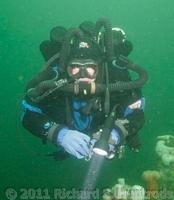
In April 2010, I started considering my diving and began wondering what my next steps might be. I spent the winter and spring diving my Prism, mostly off the Diver's Choice Charter boat, and mostly on the Nanaimo Snake Island wrecks. It is something I truely love. But spring and summer were coming, and with it full charter boats and fewer opportunities to dive the wrecks.
I spent some time talking to divers I respect, and the consensus was that I should consider becoming a SCUBA instructor. Of course, this also meant returning to Open Circuit SCUBA, primarily the single tank shore dive. I rather quickly decided this was not really a 'bad' thing. Besides, it was time to give something back to the dive community. I certainly love diving and especially love diving around Vancouver Island for the tremendous variety of underwater life as well as the local wrecks. I have also been a computer science instructor since the early 90's, and know that I am very good at it. After discussing it with my wife and with the local dive shop, I decided to take the plunge.
Shortly thereafter I began my journey to becomming an SDI OWSI (Open Water SCUBA Instructor). Glenn Sebelius was the local TDI/SDI staff Instructor Trainer, and together with Shirley and Gerald from Nanaimo Dive Outfitters we began our OWSI course. In the weeks that followed, we gave many 5-minute presentations, pool and open water presentations, as well as participating in most every Open Water SCUBA class that came along (we were all rated Divemasters so could assist the instructor as well as observe the instruction). We also practiced in-water skill demos to Glenn and each other as well as 'teaching students' (i.e. using each other). By mid May, we had completed our first phase of the instructor training with Glenn, who then signed off on each of us; ready for the next phase of training, the Instructor Evaluation Course (IEC).
The IEC was scheduled for the weekend of June 4 with Bill Coltart of Pacific Pro-Dive in Comox, B.C. (about 100km north of Nanaimo). Friday we drove up together, the better to reassure each other and recall our training. Bill turned out to be a terrific person, very easy going and friendly. He put us at ease immediately.
We started with pool skills - each of us had a primary skill to teach and evaluate using the other two as 'students'. I went first - pretty much a bundle of nerves, but managed to accomplish my task with sufficient capability to earn a pass. Shirley and Gerald also passed the pool session. We ended the pool sesson wiht a fun challenge - the snorkel underwater gear don. Wearing only a weightbelt, with Bill holding our mask, snorkel and fins on the bottom of the pool's deep end, we had to dive down and put on our gear before returning to the surface - all on one breath. I wear contacts and cannot open my eyes underwater, but I was determined to try. Using touch alone, I managed to find my mask, get it on and cleared, and then don my fins before successfully surfacing with the task accomplished - all on the first try! It was great fun!
After the pool, we headed back to present our classroom lectures. Again, we all did well and passed.
The final task was the open water presentation and skill assessment. We headed out to a site near the Comox / Powell River ferry terminal, where we accomplished our task. WE WERE DONE and WE HAD PASSED!. One thing I loved about the whole experience is that Bill used the occasion not just to examine us, but also as a training opportunity. We all learned a lot during our IEC, and it was FUN.
As we were at the surface near the dive float when we were informed of our pass, we celebrated by following Bill to the wreck of a small sailboat (about 20ft long) that had sunk in 60fsw. The wreck was home to two octopus, plus a collection of some of the largest rock cod and ling cod I had ever seen, all within a few hundred feet of the shore. I'm definitely coming back to Comox for more diving on this site!
After returning home, there was paperwork. Forms to complete and email to TDI/SDI headquarters. On June 9, 2010 I was informed that the process was complete, and I am now an SDI OWSI (Open Water SCUBA Instructor)
Now - for some teaching...
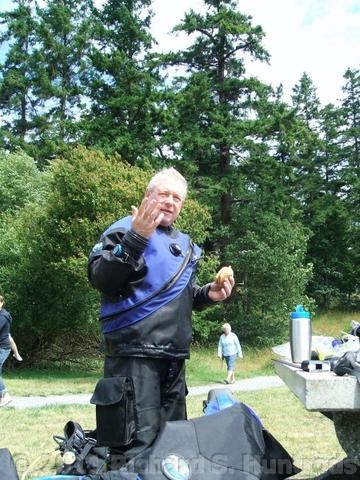
Update: March 2011. I've been teaching for Nanaimo Dive Outfitters since June of 2010, and I absolutely love it! Teaching is definitely a form of giving back to the community, and I really enjoy seeing new folks become eager divers. Shirley, Gerald and I have been team teaching since our IEC on several courses, and we've all really had a great time, as have the students.
Update: May 2018. In February 2015, I injured my left rotator cuff (shoulder) during pool sessions for SCUBA training. It was so bad that I effectively had to quit pool work for that year. 2016 passed, then 2017 and my shoulder was healing, but slowly. Finally in December 2017 I decided that I was unable to really continue teaching SCUBA, and so did not renew my PADI teaching cert, effectively retiring. Since then I've continued to dive every weekend, but mostly at Maple Bay and Chemainus, both rebreather and open circuit. These days I tend to split my dives between scootering out to the Chemainus dry docks and taking macro photos at Maple Bay. I am still loving to dive.